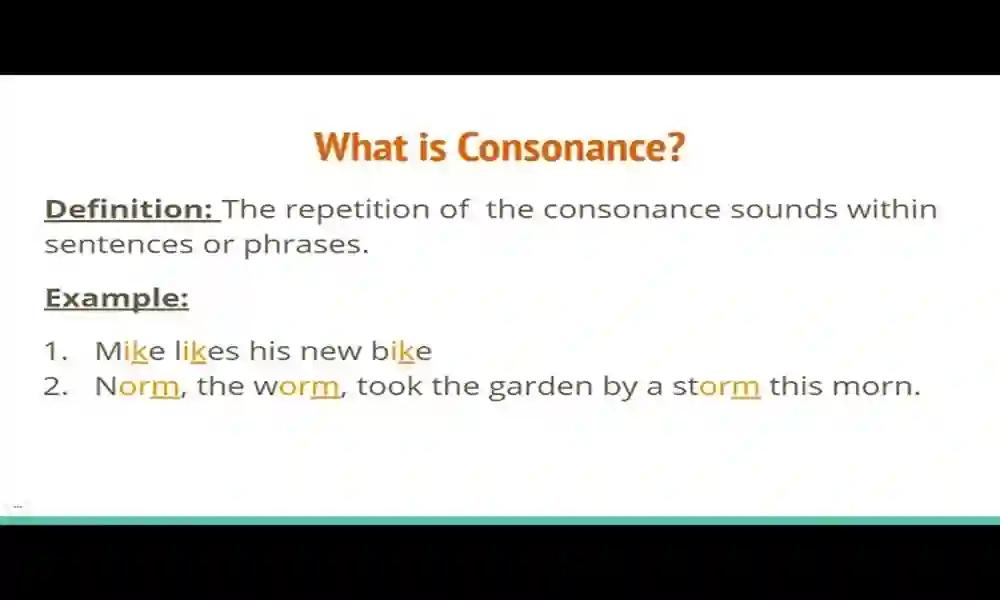
Alright, y’all. Let me just say — consonance? It’s one of those fancy literary tricks that sounds way harder than it actually is. But once you get it, bam — your writing gets that catchy, musical vibe that sticks in people’s heads like a catchy tune.
I learned this the hard way after trying to write a poem that sounded like a robot vomited words. No joke. But today, I’m gonna walk you through some wicked consonance examples that’ll have you spotting them in no time.
So, What’s Consonance Anyway?
Consonance is basically the repetition of consonant sounds. Not just at the start of words (that’s alliteration, and it’s a whole other beast), but anywhere — middle, end, you name it.
Think of the phrase, “Mike likes his new bike.” Hear that k sound? That’s consonance doing its thing.
Anyway, here’s the kicker: consonance isn’t about rhyme — it’s about sounds that create rhythm, not just words that end the same.
Why Should You Even Care?
Because consonance examples can turn bland writing into something that sounds like music.
Seriously. I once read a poem aloud that made me want to tap my foot and hum along, just because of some sneaky consonance.
And it’s not just poets — songwriters, advertisers, even casual chit-chatters use it to sound cooler. (Me? I’m still working on that.)
Consonance vs. Its Noisy Cousins
You might’ve heard of alliteration and assonance, too. Here’s the deal:
- Alliteration = consonant sounds repeated at the start of words. Like Peter Piper picked a peck — yes, we all know that one.
- Assonance = repeated vowel sounds. Think “Hear the mellow wedding bells.”
- Consonance = repeated consonant sounds anywhere but start (mostly middle or end).
Got it? Good.
Some Classic Consonance Examples in Poetry
Poets really love this stuff.
Take Edgar Allan Poe’s The Raven — “And the silken sad uncertain rustling of each purple curtain.” The s and r sounds give that eerie flutter, like the poem is literally whispering to you.
Or Dylan Thomas’s “Blind eyes could blaze like meteors and be gay.” The l and b sounds hit you like a slow drumbeat.
I swear, sometimes these poets make me wonder if they had secret soundboards or just a wicked ear.
Songs with Consonance? Heck Yeah!
You know Eminem’s Lose Yourself?
“His palms are sweaty, knees weak, arms are heavy.”
Notice all those s and h sounds? They make the tension real. I tried rapping that once — ended up looking like a fish outta water.
Taylor Swift’s Blank Space has it too: “Got a long list of ex-lovers, they’ll tell you I’m insane.” That s sound? It’s like a sly hiss that sneaks into your brain.
In Literature, Too — Not Just Poetry and Songs
Steinbeck’s Of Mice and Men throws in consonance like a seasoning: “A few miles south of Soledad, the Salinas River drops in close to the hillside bank.” See all those s and l sounds? They smooth the sentence out like butter.
And even old-school stuff like Beowulf (yes, that epic poem about a guy fighting monsters) uses consonance — “He gave them hall-high gold.” Try saying that five times fast.
Everyday Language Is Packed With Consonance
You ever notice catchy phrases that just feel right?
“All’s well that ends well.”
“The big frog was on a log.”
“A stroke of luck.”
All simple, all using consonance to sound… well, just right.
I mean, my neighbor Tina swears her kale patch cured her Zoom fatigue — and she’s not wrong. Consonance makes stuff stick, y’all.
How to Spot Consonance Like a Pro
Here’s my secret method:
- Listen. Say the phrase out loud.
- Look for repeated consonant sounds, not just letters.
- Check middle or ends of words — that’s where consonance usually hides.
Try this one: “Pitter-patter.” Bam. There’s your repeated t and r.
Or: “The early bird gets the worm.” Hear that r sound? Consonance alert.
Wanna Write Using Consonance? Here’s How
First off: don’t force it. Nothing worse than a line that sounds like a tongue-twister designed by a robot.
Instead:
- Pick a consonant sound you wanna highlight.
- Use words that feel natural together.
- Read it aloud (trust me, it’s a game changer).
Try playing around with s and t sounds in a few lines.
Pro tip: I once wrote a line with k and r sounds that sounded like a pirate’s sneeze. True story.
Fun Stuff: Consonance Activities to Get You Rolling
- Play “sound detective” in your fave songs.
- Rewrite boring sentences to add consonance.
- Match consonant sounds with phrases in a game.
I once tried a “rewrite challenge” and ended up accidentally rhyming everything — their/there mix-ups? Guilty as charged.
Oops! Common Mistakes with Consonance
Here’s what I did wrong at first:
- Mixed consonance with rhyme — easy to do if you’re tired.
- Overused consonance, so my sentences sounded like robot spam.
- Confused vowel sounds with consonants. Nitrogen-rich soil—wait, no, was it potassium? Let me Google that again… Okay, back to consonants.
The fix? Read aloud, take breaks, and maybe ask your dog if it sounds okay. Mine just barks. Not helpful.
Great Speeches Use Consonance Too
Think MLK Jr.: “I have a dream that one day every valley shall be exalted, every hill and mountain shall be made low.” Those l and d sounds? They give weight.
Or Obama: “We are not a collection of red states and blue states. We are the United States.” The t and s sounds tie it together nicely.
Quick Cheat Sheet for Consonance Sounds
| Sound | Examples |
| s | soft, hiss, miss, grass |
| l | low, wall, fall, tall |
| t | hit, bite, tight, thought |
| m | time, come, roam, stream |
| r | rare, roar, river, err |
Keep this stuck on your fridge or next to your cracked watering can from Pete’s Hardware on 5th Ave. That thing survived my overwatering phase better than my first herb garden, which died faster than my 2020 sourdough starter—RIP, Gary.
One Last Thing…
Fun fact: Victorians believed talking to ferns prevented madness. I talk to my begonias just in case.
And hey, you’ve made it this far, so congrats! Now go out there, find your own consonance examples, and maybe even write a few.









